Performance of Composite Metal Foam Armors against Various Threat Sizes
Abstract
:1. Introduction
2. Materials and Methods
2.1. Materials and Manufacturing
2.2. Ballistic Testing and Procedures
3. Results and Discussion
3.1. 14.5 mm Ballistic Testing Results
3.1.1. Armor 1: Double-Layered Ceramic-CMF-Al
3.1.2. Armor 2: RHA-Ceramic-CMF-Al
3.1.3. Armor 3: RHA-Ceramic (Tiles)-CMF-Al
3.2. Comparison to Conventional Armors
3.2.1. Mass Efficiency Ratio (MER)
3.2.2. Analytical Energy Absorption
3.3. Comparison of CMF Armors against Various AP Threats
- The increasing impact area of the larger bullets engages a greater number of spheres, improving the cushioning ability of the armor.
- The increased thickness of the CMF layer in the armor design further helps spread the load through the thickness of the armor, strengthening its performance under compression.
- A larger secondary impact zone is created as a result of the reflected stress waves in the thicker armors. The secondary impact region supports the primary impact zone around the projectile cores.
4. Conclusions
Author Contributions
Funding
Acknowledgments
Conflicts of Interest
References
- Ash, R. Lightweight Ballistic Composites: Military and Law-Enforcement Applications: Vehicle Armors, 2nd ed.; Bhatnagar, A., Ed.; Woodhead Publishing: Sawston/Cambridge, UK, 2016. [Google Scholar]
- Medvedovski, E. Ballistic performance of armour ceramics: Influence of design and structure. Part 1. Ceram. Int. 2010, 36, 2103–2115. [Google Scholar] [CrossRef]
- Medvedovski, E. Ballistic performance of armour ceramics: Influence of design and structure. Part 2. Ceram. Int. 2010, 36, 2117–2127. [Google Scholar] [CrossRef]
- Military, U.S. Armor Plate, Steel, Wrought, Homogeneous, MIL-DTL-12560K (MR) (For use in Combat-Vehicles and for Ammunition Testing); Army Research Laboratory (US), Aberdeen Proving Ground: Aberdeen, MD, USA, 2013.
- Kiliç, N.; Ekici, B. Ballistic resistance of high hardness armor steels against 7.62 mm armor piercing ammunition. Mater. Des. 2013, 44, 35–48. [Google Scholar] [CrossRef]
- Ryan, S.; Li, H.; Edgerton, M.; Gallardy, D.; Cimpoeru, S. Ballistic evaluation of an australian ultra-high hardness steel. In Proceedings of the 29th International Symposium on Ballistics, Edinburgh, UK, 9–13 May 2016; DEStech Publications, Inc.: Edinburgh, UK, 2016; Volume 2, pp. 1773–1778. [Google Scholar]
- Shen, Z.; Hu, D.; Yang, G.; Han, X. Ballistic reliability study on SiC/UHMWPE composite armor against armor-piercing bullet. Compos. Struct. 2019, 213, 209–219. [Google Scholar] [CrossRef]
- Savio, S.G.; Ramanjaneyulu, K.; Madhu, V.; Bhat, T.B. An experimental study on ballistic performance of boron carbide tiles. Int. J. Impact Eng. 2011, 38, 535–541. [Google Scholar] [CrossRef]
- Zhang, X.F.; Li, Y.C. On the comparison of the ballistic performance of 10% zirconia toughened alumina and 95% alumina ceramic target. Mater. Des. 2010, 31, 1945–1952. [Google Scholar] [CrossRef]
- Pawar, M.J.; Patnaik, A.; Biswas, S.K.; Pandel, U.; Bhat, I.K.; Chatterjee, S.; Mukhopadhyay, A.K.; Banerjee, R.; Babu, B.P. Comparison of ballistic performances of Al2O3 and AlN ceramics. Int. J. Impact Eng. 2016, 98, 42–51. [Google Scholar] [CrossRef]
- Jones, T.L.; Placzankis, B.E. The Examination of the Aluminum Alloy 7017 as a Replacement for the Aluminum Alloy 7039 in Lightweight Armor Systems; ARL-TR-7727; Army Research Laboratory (US): Aberdeen, MD, USA, 2016. [Google Scholar]
- Übeyli, M.; Deniz, H.; Demir, T.; Ögel, B.; Gürel, B.; Keleş, Ö. Ballistic impact performance of an armor material consisting of alumina and dual phase steel layers. Mater. Des. 2011, 32, 1565–1570. [Google Scholar] [CrossRef]
- Diederen, M.; Broos, J.P.F.; Trigt, S.N. Van Ballistic Protection Against Armour Piercing Projectiles Using Titanium Base Armour. Cost Eff. Appl. Titan. Alloys Mil. Platf. 2001, 99, 7–11. [Google Scholar]
- Liu, W.; Chen, Z.; Chen, Z.; Cheng, X.; Wang, Y.; Chen, X.; Liu, J.; Li, B.; Wang, S. Influence of different back laminate layers on ballistic performance of ceramic composite armor. Mater. Des. 2015, 87, 421–427. [Google Scholar] [CrossRef]
- Mikulikova, R.; Ridky, R.; Rolc, S.; Krestan, J. Influence of impact velocity and steel armour hardness on breakage of projectile 14.5 × 114 API/B32. Adv. Mil. Technol. 2018, 13, 59–69. [Google Scholar] [CrossRef] [Green Version]
- Garcia-Avila, M.; Portanova, M.; Rabiei, A. Ballistic performance of composite metal foams. Compos. Struct. 2015, 125, 202–211. [Google Scholar] [CrossRef]
- Marx, J.; Portanova, M.; Rabiei, A. Ballistic performance of composite metal foam against large caliber threats. Compos. Struct. 2019, 225, 111032. [Google Scholar] [CrossRef]
- Vendra, L.J.; Rabiei, A. A study on aluminum-steel composite metal foam processed by casting. Mater. Sci. Eng. A 2007, 465, 59–67. [Google Scholar] [CrossRef]
- Brown, J.A.; Vendra, L.J.; Rabiei, A. Bending properties of Al-steel and steel-steel composite metal foams. Metall. Mater. Trans. A Phys. Metall. Mater. Sci. 2010, 41, 2784–2793. [Google Scholar] [CrossRef]
- Rabiei, A.; Garcia-Avila, M. Effect of various parameters on properties of composite steel foams under variety of loading rates. Mater. Sci. Eng. A 2013, 564, 539–547. [Google Scholar] [CrossRef]
- Alvandi-Tabrizi, Y.; Whisler, D.A.; Kim, H.; Rabiei, A. High strain rate behavior of composite metal foams. Mater. Sci. Eng. A 2015, 631, 248–257. [Google Scholar] [CrossRef]
- Marx, J.; Portanova, M.; Rabiei, A. A study on blast and fragment resistance of composite metal foams through experimental and modeling approaches. Compos. Struct. 2018, 194, 652–661. [Google Scholar] [CrossRef]
- Rabiei, A.; Vendra, L.J. A comparison of composite metal foam’s properties and other comparable metal foams. Mater. Lett. 2009, 63, 533–536. [Google Scholar] [CrossRef]
- Vendra, L.; Rabiei, A. Evaluation of modulus of elasticity of composite metal foams by experimental and numerical techniques. Mater. Sci. Eng. A 2010, 527, 1784–1790. [Google Scholar] [CrossRef]
- Rabiei, A.; Neville, B.; Reese, N.; Vendra, L. New composite metal foams under compressive cyclic loadings. Mater. Sci. Forum 2007, 539–543, 1868–1873. [Google Scholar] [CrossRef]
- Neville, B.P.; Rabiei, A. Composite metal foams processed through powder metallurgy. Mater. Des. 2008, 29, 388–396. [Google Scholar] [CrossRef]
- Marx, J.; Rabiei, A. Overview of Composite Metal Foams and Their Properties and Performance. Adv. Eng. Mater. 2017, 19, 1600776. [Google Scholar] [CrossRef]
- Szyniszewski, S.T.; Smith, B.H.; Hajjar, J.F.; Schafer, B.W.; Arwade, S.R. The mechanical properties and modeling of a sintered hollow sphere steel foam. Mater. Des. 2014, 54, 1083–1094. [Google Scholar] [CrossRef] [Green Version]
- Ruan, D.; Lu, G.; Chen, F.L.; Siores, E. Compressive behaviour of aluminium foams at low and medium strain rates. Compos. Struct. 2002. [Google Scholar] [CrossRef]
- Miyoshi, T.; Itoh, M.; Akiyama, S.; Kitahara, A. Aluminum foam, “ALPORAS”: The production process, properties and applications. Mater. Res. Soc. Symp. Proc. 1998, 521, 133–137. [Google Scholar] [CrossRef]
- Marx, J.; Rabiei, A. Study on the Microstructure and Compression of Composite Metal Foam Core Sandwich Panels. Metall. Mater. Trans. A 2020. [Google Scholar] [CrossRef]
- Szlancsik, A.; Katona, B.; Bobor, K.; Májlinger, K.; Orbulov, I.N. Compressive behaviour of aluminium matrix syntactic foams reinforced by iron hollow spheres. Mater. Des. 2015, 83, 230–237. [Google Scholar] [CrossRef] [Green Version]
- Rizzi, E.; Papa, E.; Corigliano, A. Mechanical behavior of a syntactic foam: Experiments and modeling. Int. J. Solids Struct. 2000. [Google Scholar] [CrossRef]
- Gupta, N.; Kishore; Woldesenbet, E.; Sankaran, S. Studies on compressive failure features in syntactic foam material. J. Mater. Sci. 2001. [Google Scholar] [CrossRef]
- Balch, D.K.; O’Dwyer, J.G.; Davis, G.R.; Cady, C.M.; Gray, G.T., III; Dunand, D.C. Plasticity and damage in aluminum syntactic foams deformed under dynamic and quasi-static conditions. Mater. Sci. Eng. A 2005, 391, 408–417. [Google Scholar] [CrossRef]
- Rohatgi, P.K.; Guo, R.Q.; Iksan, H.; Borchelt, E.J.; Asthana, R. Pressure infiltration technique for synthesis of aluminum–fly ash particulate composite. Mater. Sci. Eng. A 1998, 244, 22–30. [Google Scholar] [CrossRef]
- Mondal, D.P.; Das, S.; Ramakrishnan, N.; Uday Bhasker, K. Cenosphere filled aluminum syntactic foam made through stir-casting technique. Compos. Part A Appl. Sci. Manuf. 2009. [Google Scholar] [CrossRef]
- Orbulov, I.N.; Ginsztler, J. Compressive characteristics of metal matrix syntactic foams. Compos. Part A Appl. Sci. Manuf. 2012. [Google Scholar] [CrossRef] [Green Version]
- Gupta, N.; Rohatgi, P.K. Metal Matrix Syntactic Foams: Processing, Microstructure, Properties and Applications; DEStech Publications, Inc.: Lancaster, PA, USA, 2014; ISBN 1932078835. [Google Scholar]
- Vendra, L.J. Processing and Characterization of Aluminum-Steel Composite Metal Foams. Ph.D. Thesis, North Carolina State University, NCSU ETD Repository, Raleigh, NC, USA, 2009. [Google Scholar]
- Rabiei, A. Composite Metal Foam and Methods of Preparation Thereof. U.S. Patent 9208912B2, 8 December 2015. [Google Scholar]
- Demir, T.; Übeyli, M.; Yıldırım, R.O. Investigation on the ballistic impact behavior of various alloys against 7.62mm armor piercing projectile. Mater. Des. 2008, 29, 2009–2016. [Google Scholar] [CrossRef]
- Gooch, W.A.; Burkins, M.S.; Squillacioti, R.J. Ballistic testing of commercial aluminum alloys and alternate processing techniques to increase the availability of aluminum armor. In Proceedings of the 23rd International Symposium on Ballistics, Tarragona, Spain, 16–20 April 2007; pp. 981–988. [Google Scholar]
- NATO. NATO: Protection Levels for Occupants of Armoured Vehicles, STANAG 4569, 3rd ed.; NATO: Brussels, Belgium, 2014. [Google Scholar]
- US Department of Justice Ballistic Resistance of Body Armor NIJ Standard 0101.06. 2008. Available online: https://www.ncjrs.gov/pdffiles1/nij/183651.pdf (accessed on 1 December 2019).
- Gooch, W.; Showalter, D.; Burkins, M.; Montgomery, J.; Squillacioti, R.; Nichols, A.; Martin, L.; Bailey, R.; Swiatek, G. Development and ballistic testing of a new class of auto-tempered high hard steels under military specification MIL-DTL-46100E. TMS Annu. Meet. 2009, 3, 321–328. [Google Scholar]
- Defense, D. Mil-Std-662F Test Method Standard V 50 Ballistic Test for Armor; Army Research Laboratory (US): Aberdeen, MD, USA, 1997. [Google Scholar]
- Military Specification MIL-DTL-46100E (MR), Armor Plate, Steel, Wrought, High-Hardness; Army Research Laboratory (US), Aberdeen Proving Ground: Aberdeen, MD, USA, 2008.
- Chen, S.; Bourham, M.; Rabiei, A. Attenuation efficiency of X-ray and comparison to gamma ray and neutrons in composite metal foams. Radiat. Phys. Chem. 2015. [Google Scholar] [CrossRef] [Green Version]
- Chen, S.; Marx, J.; Rabiei, A. Experimental and computational studies on the thermal behavior and fire retardant properties of composite metal foams. Int. J. Therm. Sci. 2016, 106, 70–79. [Google Scholar] [CrossRef] [Green Version]
- Gooch, W.; Burkins, M.; Squillacioti, R.; Koch, R.-M.S.; Oscarsson, H.; Nash, C. Ballistic Testing of Swedish Steel ARMOX Plate for US Armor Applications Ballistic Testing of Swedish Steel Armox® Plate for U.S. Armor Applications. In Proceedings of the 21st International Symposium on Ballistics, Adelaide, South Australia, 19–23 April 2004; pp. 19–23. [Google Scholar]
- Bassim, M.N.; Odeshi, A.G.; Bolduc, M. Deformation and failure of a rolled homogeneous armour steel under dynamic mechanical loading in compression. In Proceedings of the 12th International Conference on ‘Fracture’, New York, NY, USA, 12–17 July 2009; Volume 5, pp. 3464–3473. [Google Scholar]
- Naik, N.K.; Kumar, S.; Ratnaveer, D.; Joshi, M.; Akella, K. An energy-based model for ballistic impact analysis of ceramic-composite armors. Int. J. Damage Mech. 2013, 22, 145–187. [Google Scholar] [CrossRef]
- Chocron Benloulo, I.S.; Sánchez-Gálvez, V. A new analytical model to simulate impact onto ceramic/composite armors. Int. J. Impact Eng. 1998, 21, 461–471. [Google Scholar] [CrossRef]
- López-Puente, J.; Arias, A.; Zaera, R.; Navarro, C. The effect of the thickness of the adhesive layer on the ballistic limit of ceramic/metal armours. An experimental and numerical study. Int. J. Impact Eng. 2005, 32, 321–336. [Google Scholar] [CrossRef] [Green Version]
- Fountzoulas, C.G.; LaSalvia, J.C. Simulation of the Ballistic Impact of Tungsten-Based Penetrators on Confined Hot-Pressed Boron Carbide Targets. In Advances in Ceramic Armor VII: Ceramic Engineering and Science Proceedings; The American Ceramic Society: Columbus, OH, USA, 2011; Volume 32, pp. 261–269. [Google Scholar] [CrossRef]




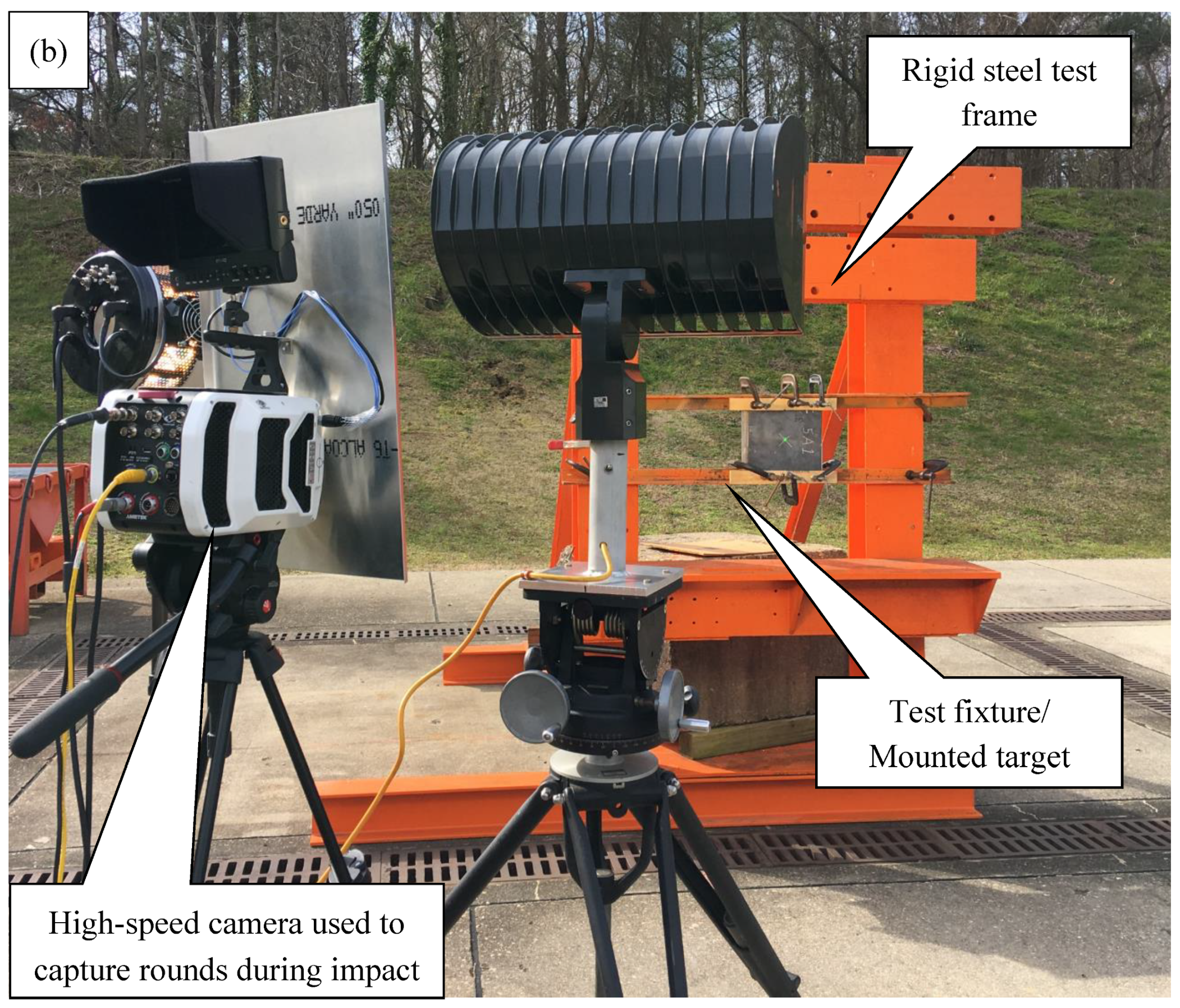
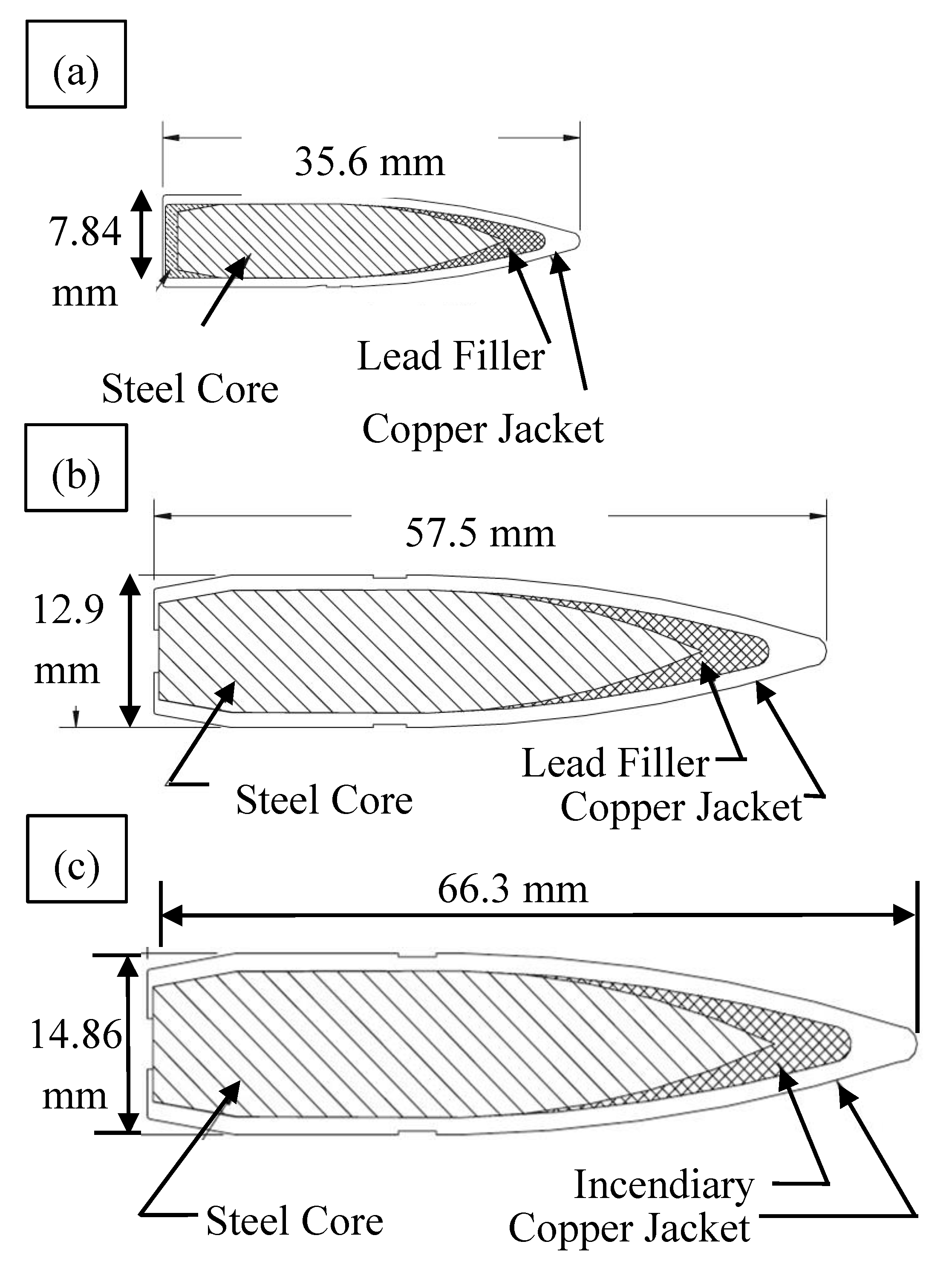
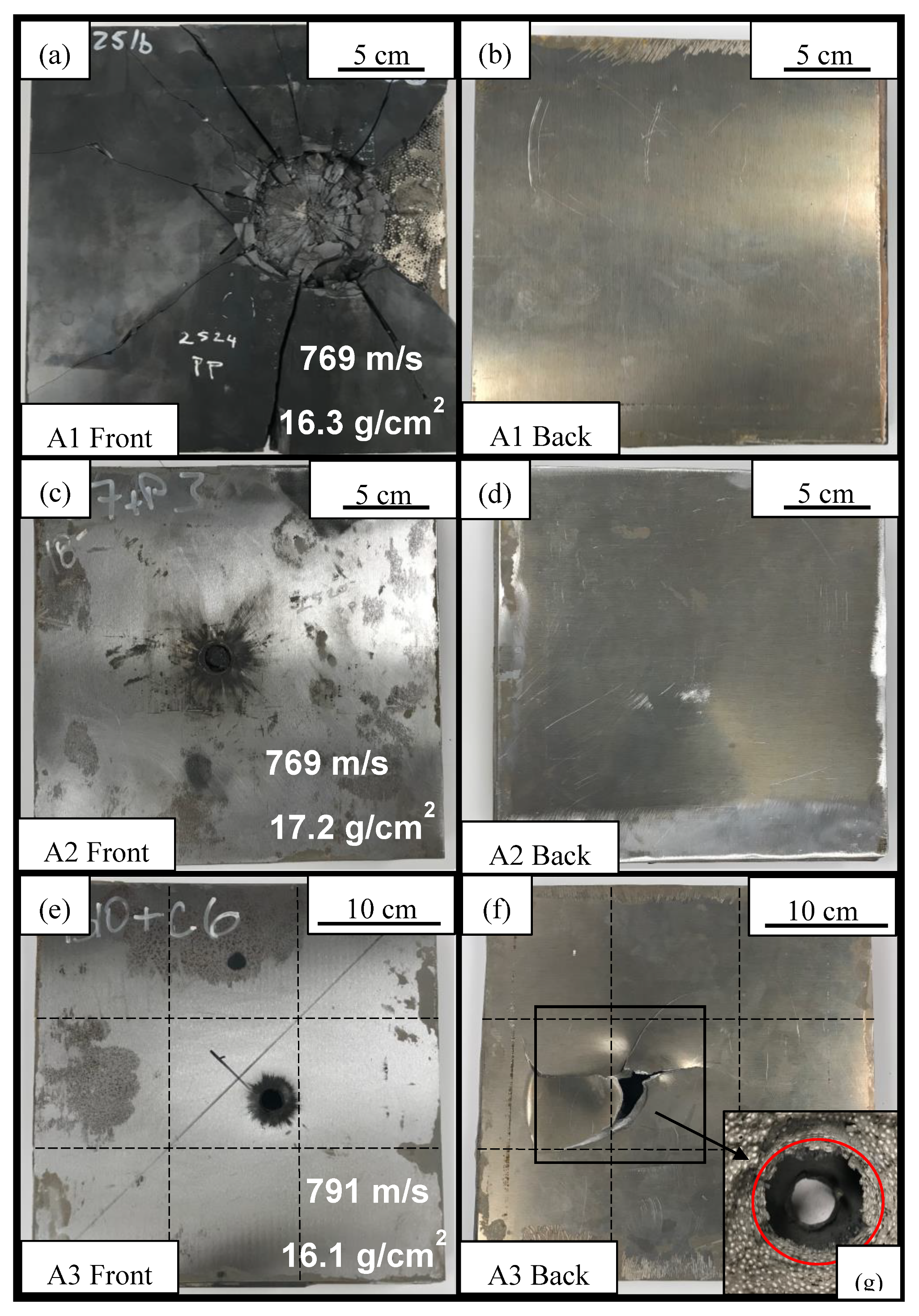
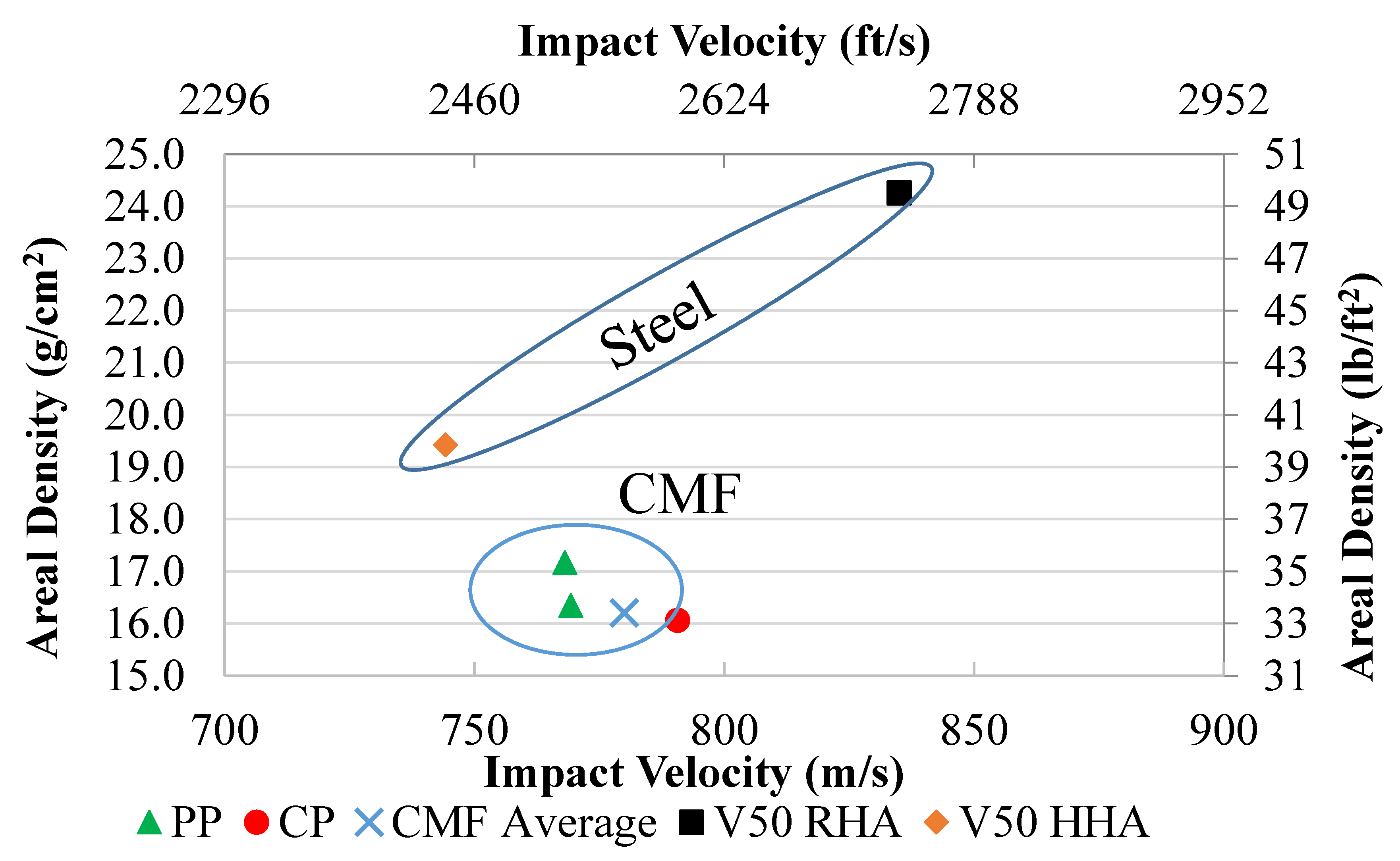
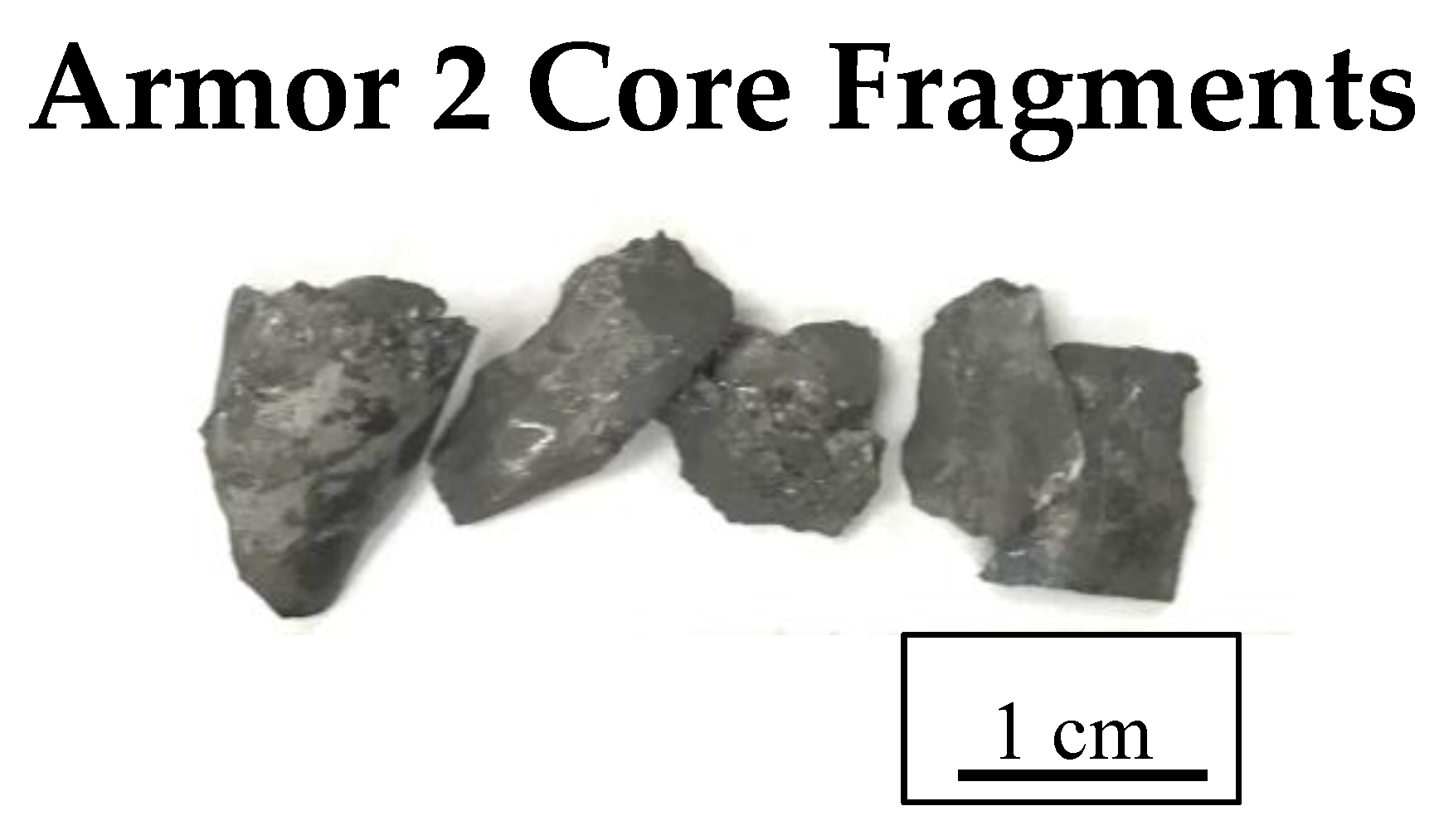


| Projectile Length (mm) | Projectile Diameter (mm) | Projectile Mass (g) | Core Length (mm) | Core Diameter (mm) | Core Mass (g) | Core Material | Impact Energy (kJ) (@ 750–900 m/s) | |
|---|---|---|---|---|---|---|---|---|
| 7.62 × 63 mm M2 AP (0.30 Cal) | 35.3 | 7.85 | 10.8 | 27.4 | 6.2 | 5.3 | Hardened Steel | 3–4 |
| 12.7 × 99 mm M2 AP (0.50 Cal) | 58.7 | 12.98 | 45.9 | 45.9 | 10.9 | 25.9 | Hardened Steel | 13–19 |
| 14.5 × 114 mm B32 API | 66.3 | 14.9 | 64.2 | 53.1 | 12.4 | 41.0 | Hardened Steel | 18–26 |
| Areal Density (g/cm2) [lb./ft2] | Impact Velocity (m/s) | Bullet Kinetic Energy (J) | PP/CP | |
|---|---|---|---|---|
| Armor 1 | 16.3 [33.5] | 769 | 19,057 | PP |
| Armor 2 | 17.2 [35.2] | 769 | 19,057 | PP |
| Armor 3 | 16.1 [32.9] | 791 | 20,129 | CP |
| Average | 16.5 [33.8] | 776 | 19,274 | - |
| HHA | 19.4 [39.7] | 744 | 17,823 | V50 [4] |
| RHA | 24.3 [49.8] | 835 | 22,451 | V50 [48] |
| Armor | Areal Density (g/cm2) [lb/ft2] | Average Round Velocity (m/s) | Total Energy of the Round (J) | Percentage of Round Energy Absorbed by: | ||||
|---|---|---|---|---|---|---|---|---|
| Ceramic and Motion of Fragment Cloud % | Bullet % | Backplate % | RHA % | CMF % | ||||
| Armor 1 | 16.3 [33.5] | 769 | 19,057 | 27 | 2 | 1 | - | 70 |
| Armor 2 | 17.2 [35.2] | 769 | 19,057 | 13 | 2 | 1 | 1 | 83 |
| 7.62 × 63 mm M2 AP [16] | 5.9 [12.1] | 867 | 4081 | 9 | 15 | 16 | - | 60 |
| 12.7 × 99 mm M2 AP [17] | 10.3 [21.1] | 804 | 15,208 | 17 | 2 | 4 | - | 77 |
| Table | Normalized Energy of the Round | Normalized Total Thickness | Normalized Areal Density |
|---|---|---|---|
| 7.62 × 63 mm M2 AP [16] | 1.00 | 1.00 | 1.00 |
| 12.7 × 99 mm M2 AP [17] | 3.72 | 1.60 | 1.77 |
| 14.5 × 114 mm B32 API | 4.67 | 2.31 | 2.90 |
Publisher’s Note: MDPI stays neutral with regard to jurisdictional claims in published maps and institutional affiliations. |
© 2020 by the authors. Licensee MDPI, Basel, Switzerland. This article is an open access article distributed under the terms and conditions of the Creative Commons Attribution (CC BY) license (http://creativecommons.org/licenses/by/4.0/).
Share and Cite
Marx, J.; Portanova, M.; Rabiei, A. Performance of Composite Metal Foam Armors against Various Threat Sizes. J. Compos. Sci. 2020, 4, 176. https://doi.org/10.3390/jcs4040176
Marx J, Portanova M, Rabiei A. Performance of Composite Metal Foam Armors against Various Threat Sizes. Journal of Composites Science. 2020; 4(4):176. https://doi.org/10.3390/jcs4040176
Chicago/Turabian StyleMarx, Jacob, Marc Portanova, and Afsaneh Rabiei. 2020. "Performance of Composite Metal Foam Armors against Various Threat Sizes" Journal of Composites Science 4, no. 4: 176. https://doi.org/10.3390/jcs4040176
APA StyleMarx, J., Portanova, M., & Rabiei, A. (2020). Performance of Composite Metal Foam Armors against Various Threat Sizes. Journal of Composites Science, 4(4), 176. https://doi.org/10.3390/jcs4040176






